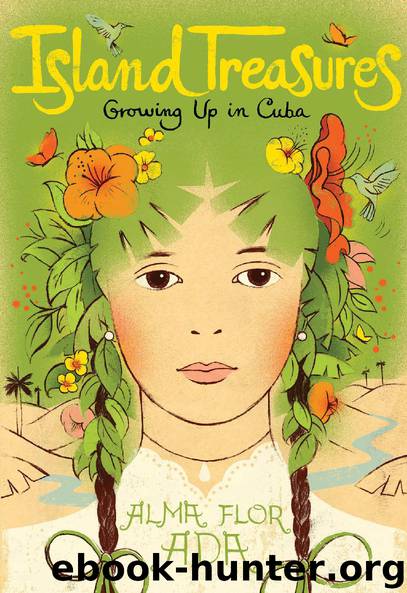Island Treasures by Alma Flor Ada

Author:Alma Flor Ada
Language: eng
Format: epub
Publisher: Atheneum Books for Young Readers
WHILE I WAS growing up I lived in Camagüey, the city where I was born, on the eastern part of Cuba, one of the many islands in the Caribbean Sea. The four larger islands in the Caribbean are called Greater Antilles. They include Hispaniola, the island shared by Haiti and the Dominican Republic; Puerto Rico; Jamaica; and Cuba. Of all these islands, Cuba, long and narrow, is the largest. It lies very close to the southern tip of Florida. Because Cuba is located at the entrance to the Gulf of Mexico, it is sometimes called “the Key to the Gulf.” On account of its beauty, its fertile land, and its incomparable weather—never too humid nor too hot—it is also called “the Pearl of the Antilles.”
When I was growing up, Camagüey was a quiet place. In Cuba we called it a city, but in a larger country it would have been called a town. Many of its streets were narrow and winding, and most were paved with stones. After a rain, the gray stones were slippery and dangerous for the horses that pulled the carts of the milkmen, the bakers, and the coal vendors. It upset me deeply whenever I saw a horse slip and fall on the wet stones.
Not many people had private cars. Most used public transportation: crowded buses, or slow and noisy streetcars called tranvías. We also probably walked much more than most people in the United States do today, to go to school or to work, to go shopping, or to visit relatives or friends in the afternoon, something we often did without giving them notice and a custom we all welcomed.
The majority of the houses had tile roofs, with gutters to gather the rainwater. The colonial houses in the center of town were spacious, usually built around a central courtyard, with large doors and windows that went from ceiling to floor and were protected by carved wooden railings.
It was a city of contrasts. Contrasts in the way people behaved, in their beliefs and in their practices. Although most people would have called Cuba a Catholic country, in reality there were people from many religious traditions. The African people who had been kept in slavery used many Catholic symbols and images to continue practicing their own beliefs under the cover of Catholicism. A few people had become Protestants, following the preaching of various American missionaries: Episcopalian, Baptist, Methodist, Adventist. There have always been Jewish people in Spanish-speaking countries, and many more arrived in Cuba fleeing Europe during World War II. Chinese people had been lured to Cuba with the promise of free land. After long years of indentured work on the fields, their perseverance and hard work had allowed most of them to settle in the cities where they owned stores, restaurants, laundry services, or vegetable gardens. Although some of them adopted Christian beliefs, many retained their ancestral religious practices. And then there were the freethinkers, maybe the fewest in number, who believed that spirituality need not be expressed under any specific set of rules.
Download
This site does not store any files on its server. We only index and link to content provided by other sites. Please contact the content providers to delete copyright contents if any and email us, we'll remove relevant links or contents immediately.
As Brave As You by Jason Reynolds(599)
So Jelly! by Coco Simon(567)
Searching for Sky by Jillian Cantor(531)
Husky by Justin Sayre(511)
The Story That Cannot Be Told by J. Kasper Kramer(466)
The Abbot's Ghost, (A Christmas Story) by Louisa May Alcott(465)
Beastkeeper by Cat Hellisen(455)
Orchards by Holly Thompson(445)
Behind A Mask by Louisa May Alcott(403)
Island Treasures by Alma Flor Ada(397)
The Demon Catchers of Milan by Kat Beyer(394)
Moods by Louisa May Alcott(393)
The Curse of the Buttons by Ylvisaker Anne(390)
A Mixture of Mischief by Anna Meriano(389)
Amber House by Kelly Moore(387)
Everything Sad Is Untrue by Daniel Nayeri(385)
They Call Me Güero by David Bowles(384)
House Without Walls by Russell(379)
The Bookwanderers by Anna James & Paola Escobar(377)
